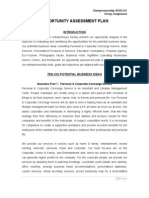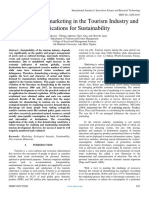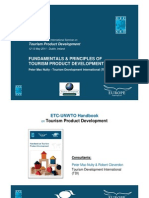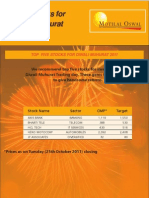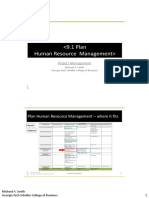0 ratings0% found this document useful (0 votes)
11 viewsTourism Product Development
Tourism Product Development
Uploaded by
christinekylle pamplonaLecture notes
Copyright:
© All Rights Reserved
Available Formats
Download as DOCX, PDF, TXT or read online from Scribd
Tourism Product Development
Tourism Product Development
Uploaded by
christinekylle pamplona0 ratings0% found this document useful (0 votes)
11 views4 pagesLecture notes
Copyright
© © All Rights Reserved
Available Formats
DOCX, PDF, TXT or read online from Scribd
Share this document
Did you find this document useful?
Is this content inappropriate?
Lecture notes
Copyright:
© All Rights Reserved
Available Formats
Download as DOCX, PDF, TXT or read online from Scribd
Download as docx, pdf, or txt
0 ratings0% found this document useful (0 votes)
11 views4 pagesTourism Product Development
Tourism Product Development
Uploaded by
christinekylle pamplonaLecture notes
Copyright:
© All Rights Reserved
Available Formats
Download as DOCX, PDF, TXT or read online from Scribd
Download as docx, pdf, or txt
You are on page 1of 4
Tourism Product Development Policy and Government – Factor
includes stability, openness to tourism,
According to UNWTO and ETC (2011), it is a
priority given to tourism development,
process whereby the assets of a particular
form of government which indicates
destination are molded to meet the needs of
level of participation allowed in
national and international customers. It
decision making and policy on tourism
encompasses all the elements with which the
investment, etc.
visitor to a destination comes into contact. It
Tourism in relation to destination’s
comprises only those attractions, activities and
overall economy – this comprises of
facilities that are specifically provided for the
level and quality of entrepreneurship,
visitors
innovation, and education, destination
Also, it can be defined as comprising only those stage in the TALC, Percentage of jobs
attractions, activities and facilities that are created by tourism, etc.
specifically provided for the visitor. Acceptability to stakeholders
– Acceptance of different stakeholders
There are two key aspects to Tourism Product such as: community members, NGOs,
Development: national Government, Industry and the
It is not an activity undertaken in a Local Government.
vacuum, but is part of an extensive and Adherence to nationally accepted
interlinked process. standards
Market Research, product development Accreditation – is a certification issued
and marketing represent a continuum. to a tourism enterprise that officially
The failure to deliver any of these key recognizes it as having complied with
components will result in the destination the minimum standards for the
under-realizing its potential. operation of tourism facilities and
services (DOT).
Prerequisite of Tourism Product Development
Tourism Product Development Process
Accessibility – The presence of
adequate transport infrastructure and According to International Labour
independence from foreign operators. Office, Tourism product development is
Factors include: trip frequencies, seat designed to increase the income in the
capacity and transportation sector. Tourism product development
connectivity in the destination involves implementation of a
Resources/existing products – range comprehensive plan of action that will
and quality of tourism resources, guide towards dealing with estimated
diversification, geographic increase in business over the short,
concentration or distribution of tourism medium and long-terms.
resources, supply and quality of human The action strategies for the
capital. It is evaluated by: quality, development and management of tourist
authenticity, uniqueness and destinations should consider the needs
composition. and interests of all stakeholders in the
Demand – The scale and trends of tourism system: local/ rural community,
current market demand, forecast entrepreneurs, investors, governments,
growth rate, ability of destination to tourists and other stakeholders.
offer products matching the tastes and Tourism Product Development Process:
characteristics of the market, etc.
1. Identify tourism assets.
2. Match assets with potential markets Product Development Practices
3. Make the product more inviting, such as by Design the activities that are suitable for
providing infrastructure the place’s natural assets
Take advantage of the terrain and other
4. Develop activities around the tourism assets.
natural features, such as zipline of
5. Develop tour packages. hanging bridge on a hilly area.
Take advantage of man-made features.
6. Communicate benefits to target markets. Turn disasters into a tourist product like
7. Develop a destination marketing organization voluntourism or dark tourism.
(DMO) Tourism Product Development Process Create products from events.
If the place has no distinctive natural
Tourism Product Development Principles: assets, develop man- made attractions.
Hi-touch strategy – Personalize service
Tourism product development should:
quality and develop service styles.
be authentic and indigenous reflect the Hi-tech strategy – Use technology to
unique attributes of the destination. create exclusivity and an aura of
have the support of the host community. sophistication.
respect the natural and socio-cultural Invent new product class.
environments by not damaging these in Find use for a negative attribute (mud
any way. festival in Korea).
be differentiated from competitors, Use the Eco-brand in places which are
avoid “me too/copycat” developments. infrastructure- deficient.
be of sufficient scale to make a Advocacy – appeal to the tourist’s sense
significant economic contribution, but of justice, compassion and ethics.
not large as to create high economic Localize – Go native • Celebrate local
leakage. products (ex. Crocodile meat in Puerto
Princesa)
Product Diversification Strategy Complement do not compete (ex. Vigan
– Laoag tour package)
Incorporate other activities into the main
activity
Find niche; differentiate
Provide certificates with accompanying
photographs to create a sense of
reaching a milestone (ex. Crown
Regency Hotel Sky Adventure
Experience).
Discover the story behind the attraction PESTEL analysis is an acronym for a tool used
and use it for interpretation. to identify the macro (external) forces facing an
Use unlikely places and materials. organization. The letters stand for Political,
Economic, Social, Technological, Environmental
The Present Situation Analysis
and Legal. Depending on the organization, it can
The overall priorities and policies for the be reduced to PEST or some areas can be added
tourism sector having been established, the (e.g. Ethical)
approach to the task of investigating the
ELEMENT OF A PESTEL ANALYSIS
potential for Tourism Product Development, and
turning the opportunities identified into Political Factors - These determine the
successful and sustainable developments that extent to which government and
meet the market’s requirements for innovation, government policy may impact on an
differentiation and authenticity, involves a three- organization or a specific industry. This
stage process as follows: would include political policy and
stability as well as trade, fiscal and
• establishing the present situation;
taxation policies too.
•identifying the opportunities; and Economic Factors - These factors
impact on the economy and its
• prioritizing the destination’s own tourism performance, which in turn directly
sector’s objectives impacts on the organization and its
profitability. Factors include interest
rates, employment or unemployment
rates, raw material costs and foreign
exchange rates.
Social Factors - These factors focus on
the social environment and identify
emerging trends. This helps a marketer
to further understand their customers’
1. Where they are in terms of their political and needs and wants. Factors include
socio-economic development – the backcloth for changing family demographics,
tourism development. This is undertaken education levels, cultural trends, attitude
through PEST analysis – political, economic, changes and changes in lifestyles.
sociocultural, technological; Technological Factors - These factors
consider the rate of technological
2.what their competitive position is, obtained innovation and development that could
through SWOT analysis – strengths, affect a market or industry. Factors
weaknesses, opportunities, threats; could include changes in digital or
3.where they are on the tourism area life cycle mobile technology, automation, research
(TALC); and development. There is often a
tendency to focus on developments only
4. Whether they are facing a challenge of in digital technology, but consideration
market development, product development or must also be given to new methods of
both through use of the Ansoff Matrix; and distribution, manufacturing and also
logistics.
5. Where their existing product range fits on the
Environmental Factors - These factors
Boston Consulting Group Matrix (e.g. star,
relate to the influence of the surrounding
problem child, cash cow or dog)
environment and the impact of
ecological aspects. With the rise in Development stage is characterized by
importance of CSR (Corporate rapid tourism growth and dramatic
Sustainability Responsibility), this changes over a relatively short period of
element is becoming more important. time in all aspects of the tourism sector.
Factors include climate, recycling Consolidation stage involves a decline
procedures, carbon footprint, waste in the growth rate of visitor arrivals and
disposal and sustainability. other tourism-related activity, although
Legal Factors - An organization must the total amount of activity continues to
understand what is legal and allowed increase.
within the territories they operate in. Stagnation stage is where peak visitor
They also must be aware of any change numbers and levels of associated
in legislation and the impact this may facilities, such as available
have on business operations. Factors accommodation units, are attained.
include employment legislation, Decline where the destination will
consumer law, healthy and safety, eventually experience either an upturn
international as well as trade regulation or a downturn in its fortunes or
and restrictions. Rejuvenation where it is almost always
accompanied by the introduction of
Destination Cycles (TALC)
entirely new tourism products, or at least
The idea that destinations experience a the radical reimaging of the existing
predictable evolution is embodied in the concept product, as a way of recapturing the
of the destination cycle. This theory, to the destination’s competitive advantage and
extent that it is demonstrated to have widespread sense of uniqueness.
relevance to the real world, is of great interest to
tourism managers, who would then know where
a particular destination is positioned within the
cycle at a given point in time and what
implications this has for the future if no
intervention is undertaken.
The Butler Sequence
Butler in 1980 presented his S-shaped resort
cycle model, or Butler sequence, which proposes
that tourist destinations tend to experience five
distinct stages of growth (i.e. exploration,
involvement, development, consolidation,
stagnation) under free market and sustained
demand conditions (Butler, 1980).
Exploration stage is characterized by
very small numbers of visitors who are
dispersed throughout the destination and
remain for an extended period of time.
Involvement stage is associated with
strongly positive community attitudes
toward tourism.
You might also like
- Certificate of Increase of Capital StockDocument2 pagesCertificate of Increase of Capital StockNarciso Reyes Jr.89% (9)
- Opportunity Assessment PlanDocument18 pagesOpportunity Assessment PlanSteffie67% (6)
- TPDT Prelim ReviewerDocument3 pagesTPDT Prelim ReviewerNICOLE BEATRIZ VERGARANo ratings yet
- 1 Professional Education Tourism Product DvelopmentDocument17 pages1 Professional Education Tourism Product DvelopmentAngelica LozadaNo ratings yet
- Week 2 2.0 The Tourism Product-Factors Governing DemandDocument13 pagesWeek 2 2.0 The Tourism Product-Factors Governing DemandGrace ArtuzNo ratings yet
- Arizain ST Paul English A SBA PDFDocument23 pagesArizain ST Paul English A SBA PDFChelsea Ronalds100% (2)
- Business Tourism As Innovative Product For Destinations: January 2015Document9 pagesBusiness Tourism As Innovative Product For Destinations: January 2015Ray KNo ratings yet
- Adhd TPD ReviewerDocument14 pagesAdhd TPD ReviewerBea San JuanNo ratings yet
- Week 4 - Fundamentals and Principles of Tourism Product Development PlanningDocument5 pagesWeek 4 - Fundamentals and Principles of Tourism Product Development PlanningESPORTS HanaNo ratings yet
- 1-Basic Concepts in Tourism Planning and DevelopmentDocument40 pages1-Basic Concepts in Tourism Planning and DevelopmentAngelhee A PlacidoNo ratings yet
- Reviewer Macro7Document7 pagesReviewer Macro7Glen joseph SerranoNo ratings yet
- Tourism Product Development Midterm TopicDocument19 pagesTourism Product Development Midterm Topicmicah morelosNo ratings yet
- Unit 5 ModuleDocument6 pagesUnit 5 ModuleJerome Ubilas EstrellaNo ratings yet
- Week+4 Tourism Product DevelopmentDocument11 pagesWeek+4 Tourism Product DevelopmentRachelle Mae SalvadorNo ratings yet
- Tourist Destination & Attractions - ReviewerDocument7 pagesTourist Destination & Attractions - ReviewerAdrian MarananNo ratings yet
- Nature of Tourism As An IndustryDocument4 pagesNature of Tourism As An IndustryAira Lonto100% (1)
- Analyzing The Importance of Service Quality and Customer Satisfaction in The Tourism IndustryDocument15 pagesAnalyzing The Importance of Service Quality and Customer Satisfaction in The Tourism IndustryhortensiasfamfestNo ratings yet
- Leveraging Export Brands Through A Tourism Destination BrandDocument19 pagesLeveraging Export Brands Through A Tourism Destination BrandJennifer LaraNo ratings yet
- BTM 3411 Tourism Product Development 1 1Document6 pagesBTM 3411 Tourism Product Development 1 1ARJAY PUNONGBAYANNo ratings yet
- Tourism DevelopmentDocument16 pagesTourism DevelopmentZhiana Thea MoralNo ratings yet
- Sustainable MidtermDocument6 pagesSustainable MidtermJulienne DumaelNo ratings yet
- C 3 Promotion&productDocument55 pagesC 3 Promotion&productNguyễn Ngọc ThắngNo ratings yet
- Tourism Destination MGT NotesDocument8 pagesTourism Destination MGT NotesCarzo Aggy Mugy100% (1)
- 03chapters5 6 PDFDocument28 pages03chapters5 6 PDFJammie Fritz CastilloNo ratings yet
- TPD L2 PDFDocument5 pagesTPD L2 PDFJastine Althea Terado CuentasNo ratings yet
- Tpad ReviewerDocument12 pagesTpad ReviewerCarl ReyesNo ratings yet
- Conjunctions Prepositions and Interjections Language Review Game Presenta 20240920 211237 0000 (1)Document21 pagesConjunctions Prepositions and Interjections Language Review Game Presenta 20240920 211237 0000 (1)diamaesuguihan06No ratings yet
- Module 4-Tourism ProductDocument17 pagesModule 4-Tourism ProductmaeganericapNo ratings yet
- SWOT Analysis in The Formulation of Tourism DeveloDocument10 pagesSWOT Analysis in The Formulation of Tourism Develoalicevu3430No ratings yet
- Tourism Marketing 2021 4 LectureDocument41 pagesTourism Marketing 2021 4 LectureHoàng MaiNo ratings yet
- Chapter 5 The Tourism Hospitality ProductDocument4 pagesChapter 5 The Tourism Hospitality ProductNiczandra Mae RoledaNo ratings yet
- The Brand - An Increasing Factor of A Tourist Destination'S CompetitivenessDocument6 pagesThe Brand - An Increasing Factor of A Tourist Destination'S Competitivenessankitspx2010No ratings yet
- MILENARATAJCZAK MROZEKemacDocument8 pagesMILENARATAJCZAK MROZEKemacBinakadara JayasankaNo ratings yet
- Destination Planning Concepts: Kavya Vinay I 08 I M2 I GectDocument10 pagesDestination Planning Concepts: Kavya Vinay I 08 I M2 I Gectkavya vinayNo ratings yet
- Explain The Concept of Tourism Product and Identify Its Components. (25 PTS)Document2 pagesExplain The Concept of Tourism Product and Identify Its Components. (25 PTS)Jesa May AbanNo ratings yet
- Unit 2 Tourism PlanningDocument12 pagesUnit 2 Tourism PlanningKshitiz RawalNo ratings yet
- 2024 - Field Trip On Tourism Cluster - LantauDocument4 pages2024 - Field Trip On Tourism Cluster - Lantauluk.wingwing620No ratings yet
- Tourism PolicyDocument13 pagesTourism PolicyAdhithy BalakrishnanNo ratings yet
- Unit - 4Document22 pagesUnit - 4puskarcing16No ratings yet
- TPDT 411_PRELIM REVIEWERDocument11 pagesTPDT 411_PRELIM REVIEWERBALANE KENNETHNo ratings yet
- Role of Public and Private Sector in Tourism: Presented By: Ashish KaushikDocument32 pagesRole of Public and Private Sector in Tourism: Presented By: Ashish Kaushikrainydawar100% (2)
- Evolution of Demarketing in The Tourism Industry and Implications For Sustainability - IJISRT19OCT2080 PDFDocument6 pagesEvolution of Demarketing in The Tourism Industry and Implications For Sustainability - IJISRT19OCT2080 PDFAGBOOLA OLUGBENGA MAYOWANo ratings yet
- Chapter 1Document26 pagesChapter 1Cayenne GepolongcaNo ratings yet
- Week 9Document3 pagesWeek 9MonikNo ratings yet
- Week 9Document3 pagesWeek 9MonikNo ratings yet
- The Role of The Public Sector in Developing Tourism Product Strategies For Tourism DestinationsDocument14 pagesThe Role of The Public Sector in Developing Tourism Product Strategies For Tourism DestinationsTomi SitumorangNo ratings yet
- Branding Building For Vietnam Tourism Industry Reality and SolutionsDocument7 pagesBranding Building For Vietnam Tourism Industry Reality and Solutionsliennth1994No ratings yet
- GROUP 5 - CILO 3.2 - Strategy and Approaches in Tourism Product Development - BSTM - 1ADocument8 pagesGROUP 5 - CILO 3.2 - Strategy and Approaches in Tourism Product Development - BSTM - 1AleslyNo ratings yet
- Fundamentals and Principles of Tourism Product Development - Peter Mac NultyDocument45 pagesFundamentals and Principles of Tourism Product Development - Peter Mac NultyRavinesh Dutt67% (3)
- Tourism Product Development Dds Esade 3r May 2006Document14 pagesTourism Product Development Dds Esade 3r May 2006MillaNo ratings yet
- 4758 13523 1 PBDocument8 pages4758 13523 1 PBTesfaye AdugnawNo ratings yet
- Project Development For Sustainable Tourism: A Step by Step ApproachDocument79 pagesProject Development For Sustainable Tourism: A Step by Step ApproachEvah Boemo MosetlhaneNo ratings yet
- DD Strategy For EthiopiaDocument7 pagesDD Strategy For EthiopiayisfalignNo ratings yet
- Tourism As A Vehicle For Local Economic Development: Roselyn B. Quintana Division Chief, LGCDD Dilg R6Document34 pagesTourism As A Vehicle For Local Economic Development: Roselyn B. Quintana Division Chief, LGCDD Dilg R6Giselle GerialNo ratings yet
- WASTEDocument8 pagesWASTE22-72418No ratings yet
- Global Directions of Travel and Tour SectorDocument13 pagesGlobal Directions of Travel and Tour SectorJoseph Louis BautistaNo ratings yet
- Chapter 5Document7 pagesChapter 5NICE DELA CRUZNo ratings yet
- Unit 7Document17 pagesUnit 7Mahak ShivhareNo ratings yet
- Tourism Management: Abdelati M. Benur, Bill BramwellDocument12 pagesTourism Management: Abdelati M. Benur, Bill Bramwellİsmet KarataşNo ratings yet
- Chapter 4b Course PackDocument9 pagesChapter 4b Course Pack842nqwhskcNo ratings yet
- Guia de Buenas Practicas en Innovacion para DTI - ENDocument34 pagesGuia de Buenas Practicas en Innovacion para DTI - ENbagus wiraNo ratings yet
- Promoting Smart Tourism in Asia and the Pacific through Digital Cooperation: Results from Micro, Small, and Medium-Sized Enterprise SurveyFrom EverandPromoting Smart Tourism in Asia and the Pacific through Digital Cooperation: Results from Micro, Small, and Medium-Sized Enterprise SurveyNo ratings yet
- MOSt Stocks DiwaliDocument6 pagesMOSt Stocks DiwaliSuresh Babu ANo ratings yet
- Bucharest Business Week (Samples)Document4 pagesBucharest Business Week (Samples)Cristi CiureanuNo ratings yet
- Quantitative EasingDocument13 pagesQuantitative EasingCarlos E. Japay RoblesNo ratings yet
- Unit 1 THE BUSINESS OF BUSINESSDocument3 pagesUnit 1 THE BUSINESS OF BUSINESStrangnguyen.31231024787No ratings yet
- 2019 09 20 New Balance Harvard Business CaseDocument7 pages2019 09 20 New Balance Harvard Business CaseFrans AdamNo ratings yet
- Marketing Research EssentialDocument21 pagesMarketing Research EssentialAlvaro FlorezNo ratings yet
- INRIX 2015 Traffic Scorecard ReportDocument17 pagesINRIX 2015 Traffic Scorecard ReportChristina SturdivantNo ratings yet
- RattanDocument5 pagesRattanInternational Journal of Innovative Science and Research TechnologyNo ratings yet
- DG KhanDocument3,608 pagesDG KhanKhawaja BurhanNo ratings yet
- Group 5 BNM & AmlaDocument32 pagesGroup 5 BNM & AmlaSitiSarahNo ratings yet
- PMBOK 09 1 Plan Human Resource Management PDFDocument12 pagesPMBOK 09 1 Plan Human Resource Management PDFamirNo ratings yet
- Assignment Strategic ManagementDocument9 pagesAssignment Strategic ManagementHarpal PanesarNo ratings yet
- HULDocument103 pagesHULEven You, CanNo ratings yet
- Cost AccountingDocument59 pagesCost AccountingDitto SabuNo ratings yet
- Performance Appraisal Bajaj AllianzDocument118 pagesPerformance Appraisal Bajaj Allianzaryanboxer78663% (8)
- Reviewer Strat CostDocument20 pagesReviewer Strat CostMiriam Ubaldo DanielNo ratings yet
- Basis of AccountingDocument5 pagesBasis of AccountingAarush GuptaNo ratings yet
- FNC 345 - CH 11 - Capital BudgetingDocument7 pagesFNC 345 - CH 11 - Capital Budgetingwaqaramjad23No ratings yet
- Kreag Impacts TourismDocument27 pagesKreag Impacts Tourismapi-3705217No ratings yet
- Stock ItemsDocument9 pagesStock ItemsRAGHUNATH BEHERANo ratings yet
- Buying and Selling: Lesson 7Document31 pagesBuying and Selling: Lesson 7귀여워gwiyowoNo ratings yet
- Effects of Online Shopping On Customers Online Buying BehaviorDocument34 pagesEffects of Online Shopping On Customers Online Buying BehaviorZoe Bantilan Mirando0% (2)
- ACT301 Week 3 Tutorial PDFDocument3 pagesACT301 Week 3 Tutorial PDFjulia chengNo ratings yet
- MKC FinalDocument12 pagesMKC FinalRita MurrayNo ratings yet
- EN - CSR - 20221125 - Corporate Social Responsibilty and The Legal Profession Key Considerations For Bars and LawyersDocument29 pagesEN - CSR - 20221125 - Corporate Social Responsibilty and The Legal Profession Key Considerations For Bars and LawyersAci AndariNo ratings yet
- 580621Document5 pages580621mohitgaba19No ratings yet
- SCM Unit 1Document43 pagesSCM Unit 1rpulgam09No ratings yet

